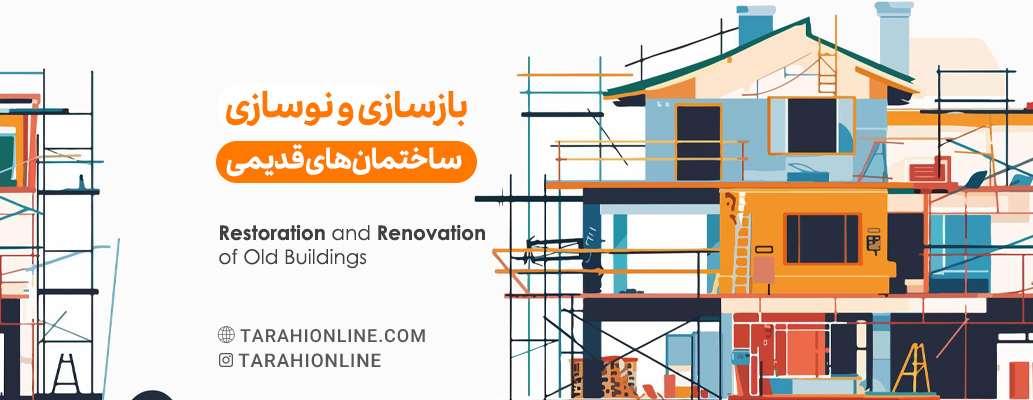
Restoration and renovation of old buildings is a complex and challenging process that not only helps improve the functionality and aesthetics of old buildings but also preserves cultural and historical heritage. This process can include significant structural changes, improvement of mechanical and electrical systems, and even changes in the building’s usage. Below, we will explore various aspects of restoring and renovating old buildings.
Preserving Cultural and Historical Heritage
One of the most important goals of restoring and renovating old buildings is to preserve their cultural and historical heritage. Old buildings often have historical, architectural, and cultural values that need to be preserved. Restoring these buildings requires thorough research and a complete understanding of their history and unique features. Engineers and architects must use modern methods in accordance with historical preservation principles to maintain these values.
To preserve cultural and historical heritage, a detailed examination of the building and its history is essential. This includes studying original blueprints, old photographs, and any historical documents related to the building. Collaborating with archaeologists and art historians can help identify the unique features and values of the building. Finally, using appropriate materials and techniques to restore damaged parts while maintaining the authenticity of the building is crucial.
Improving Energy Efficiency
Another goal of renovating old buildings is to improve their energy efficiency. Many old buildings are energy inefficient and need optimization. Using better insulation, installing modern heating and cooling systems, and utilizing renewable energy sources can help reduce energy consumption and operational costs.
Insulating the walls, roof, and floor of the building can significantly reduce heat loss. Installing double-glazed windows and insulated doors can also enhance energy efficiency. Additionally, using high-efficiency heating and cooling systems and renewable energy sources like solar panels and geothermal systems can help reduce reliance on fossil fuels.
Enhancing Mechanical and Electrical Systems
Renovating old buildings often includes improving mechanical and electrical systems. Heating, ventilation, air conditioning (HVAC), and electrical systems in old buildings are usually outdated and inefficient. Renovating these systems with modern and efficient technologies can enhance the comfort and safety of occupants.
Modern heating and cooling systems usually have higher efficiency and lower energy consumption compared to old systems. Improving electrical systems includes installing new wiring, modern electrical panels, and energy-efficient lighting systems, which can increase the building’s overall efficiency.
Changing Building Usage
In some cases, renovating old buildings includes changing their usage. For example, converting an old factory into modern residential space or turning an old school into a cultural center. These changes not only help preserve old buildings but also revitalize urban areas and increase their economic value.
Changing building usage usually requires significant changes in the design and structure of the building. This includes alterations in the internal layout, installing new equipment and facilities, and improving infrastructure. Additionally, this process can aid in urban renewal and create new spaces for economic, cultural, and social activities.
Using Sustainable Materials
Using sustainable and recycled materials is very important in the process of renovating old buildings. Using materials with minimal environmental impact that can be easily recycled helps preserve the environment and reduce construction waste.
Using recycled materials like reclaimed wood, recycled bricks, and recycled metals can reduce the consumption of natural resources and decrease construction waste. Additionally, using materials with environmental attributes like high durability, recyclability, and low pollutant emissions can improve the project’s sustainability.
Improving Accessibility and Safety
Renovating old buildings provides an opportunity to improve their accessibility and safety. Installing elevators, emergency staircases, fire alarm and extinguishing systems, and enhancing accessibility for individuals with disabilities are some actions that can be undertaken during the renovation process.
Improving accessibility and safety includes installing fire alarm and extinguishing systems, enhancing emergency lighting, installing safety railings, and improving access to staircases and elevators for individuals with disabilities. These actions can increase the safety and comfort of the building’s occupants and users.
Economic Efficiency
Restoration and renovation of old buildings not only help preserve cultural heritage and improve building efficiency but are also economically efficient. Renovating old buildings can reduce maintenance costs, increase the economic value of the building, and even create new job opportunities.
Renovating old buildings usually costs less than constructing new buildings and can contribute to the economic efficiency of the project. Additionally, renovating old buildings can attract investment and increase the economic value of urban areas.
Restoration and renovation of old buildings is a multifaceted and complex process that requires careful planning and collaboration among engineers, architects, and preservation specialists. Given the cultural, historical, and economic importance of these buildings, their renovation not only helps improve the living and working conditions of occupants but also aids in preserving the cultural and historical identity of communities. Utilizing modern technologies and sustainable materials, optimizing energy consumption, and improving accessibility and safety are important actions that should be considered in this process.